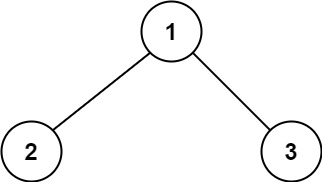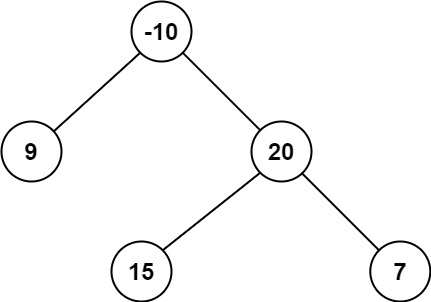LeetCode-in-All
124. Binary Tree Maximum Path Sum
Hard
A path in a binary tree is a sequence of nodes where each pair of adjacent nodes in the sequence has an edge connecting them. A node can only appear in the sequence at most once. Note that the path does not need to pass through the root.
The path sum of a path is the sum of the node’s values in the path.
Given the root of a binary tree, return the maximum path sum of any non-empty path.
Example 1:

Input: root = [1,2,3]
Output: 6
Explanation: The optimal path is 2 -> 1 -> 3 with a path sum of 2 + 1 + 3 = 6.
Example 2:

Input: root = [-10,9,20,null,null,15,7]
Output: 42
Explanation: The optimal path is 15 -> 20 -> 7 with a path sum of 15 + 20 + 7 = 42.
Constraints:
- The number of nodes in the tree is in the range
[1, 3 * 104]. -1000 <= Node.val <= 1000
Solution
#include <stdio.h>
#include <limits.h>
/**
* Definition for a binary tree node.
* struct TreeNode {
* int val;
* struct TreeNode *left;
* struct TreeNode *right;
* };
*/
// Initialize max to a very low value
int max = INT_MIN;
int helper(struct TreeNode* root) {
if (root == NULL) {
return 0;
}
// Recursively get the maximum path sum for left and right subtrees
int left = helper(root->left);
int right = helper(root->right);
// Ensure negative values are replaced by 0
left = (left > 0) ? left : 0;
right = (right > 0) ? right : 0;
// Calculate the current maximum path sum through this node
int current = root->val + left + right;
// Update global max if current is greater
if (current > max) {
max = current;
}
// Return the maximum path sum including this node and one of its subtrees
return root->val + ((left > right) ? left : right);
}
int maxPathSum(struct TreeNode* root) {
max = INT_MIN; // Reset max for each function call
helper(root);
return max;
}
// Helper function to create a new tree node
struct TreeNode* createNode(int val) {
struct TreeNode* node = (struct TreeNode*)malloc(sizeof(struct TreeNode));
node->val = val;
node->left = NULL;
node->right = NULL;
return node;
}

